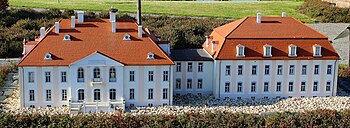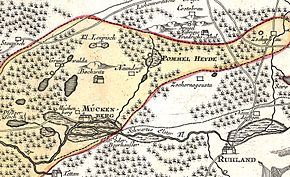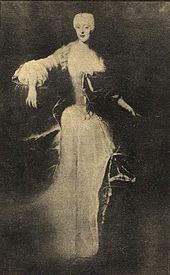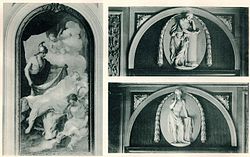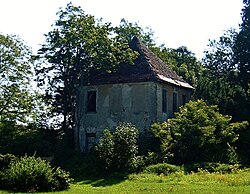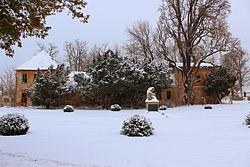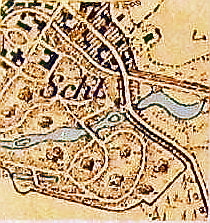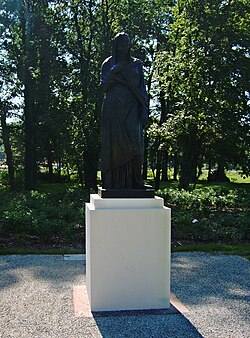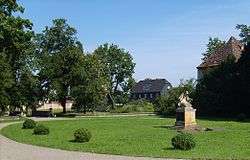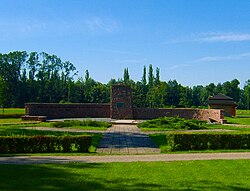Mückenberg Castle
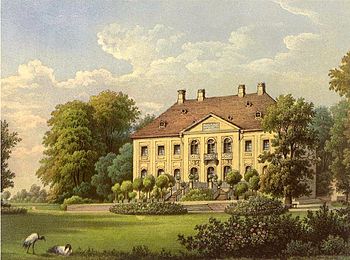
Mückenberg Castle was a castle in the south of the city of Mückenberg , which has been part of Lauchhammer in southern Brandenburg since 1950 .
The first documented mention of a castle in Mückenberg comes from the year 1278. Baroness Benedicta Margareta von Löwendal , who moved her residence to Mückenberg in 1716 and is considered the founder of today's industrial site with the establishment of the Lauchhammerwerk , had the old buildings demolished and a new palace complex in 1735 erect. Shortly before its completion, the building fell victim to a fire due to the inattention of several carpenters. The immediately rebuilt castle, a two-story three-wing building, could finally be moved into in 1737.
The building burned in the last days of World War II by arson down to its foundations. The ruin was later removed. The former castle park, the castle church and some outbuildings have been preserved.
History of Mückenberg Castle and Rulership
Mückenberg Castle
Around 1000, in the course of the expansion of the German state east of the Elbe, there were military conflicts between the expanding Holy Roman Empire and the Slavic rulers residing there. At the same time, Polish dukes and kings also began to expand from the east, which led to further conflicts. Several castles were therefore newly founded or expanded along the Black Elster, which served both to protect and control the military and trade routes running parallel to the river, as well as to secure the river crossings and the settlements that were being built here.
The first documentary evidence of Mückenberg is the mention of the Cunczo Schoff de Monte Miconis from 1278. According to tradition, the Wendish fishing village is said to be near the castle, which secured a dam connected by several bridges through the marshy Elstern lowland towards the edge of the town Puketzscha have found. It later grew together with the German settlement that followed the castle and had city rights. The rule Mückenberg even Mückenberger Ländchen or lendichen called covered not only Mückenberg the places Bockwitz , Naundorf , Dolsthaida , Kleinleipisch , Grünewalde , later the Gutsbezirk Lauchhammer and at times also the places Schipkau and Särchen , today Annahütte.
The Schoff (Schaff) were resident in Mückenberg until the end of the 14th century. They were followed in 1398 by Heinrich von Waldau, who presumably bought it from Luther Schaff and in 1405 also took over the Würdenhain castle and rule . The von Waldau family remained in possession of the rule until 1417, which they passed on to the von Köckritz family . The noble family, which was very influential at the time, stayed there until the 16th century. Due to his numerous possessions in the transition country between the Mark Meissen and Niederlausitz, he was able to build up a territory that was relatively independent of the office.
The later Meissnian noble family von Schleinitz was first mentioned in Mückenberg in 1506. At that time it also owned the Saathain lordship about 20 kilometers to the west . The old overland connection between the two rulers, the so-called Schleinitzweg , owes its name to him.
Baroness of Löwendal
In 1716 the electoral Saxon court marshal and cabinet minister Woldemar Freiherr von Löwendal , who had owned the neighboring rule of Elsterwerda since 1708 , acquired the two dominions of Mückenberg and Saathain. He soon left Mückenberg as a residence to his wife Benedicta Margareta , who received the rule with the six associated villages as hereditary property and in 1722 as a state fief. Three years later, the Baroness was granted feudal rights to operate an iron foundry, the Lauchhammer , by the Saxon Elector August the Strong , which laid the foundation for today's industrial site in Lauchhammer.
In Mückenberg she had the old, dilapidated castle complex torn down in 1735. The almost completed successor building burned down with the inventory on the night of February 27-28, 1737. The damage to the castle amounted to a total of 10,400 thalers. The fire also spread to the neighboring town, where 17 farms burned down.
In the same year Baroness Benedicta Margareta von Löwendal had a palace built again in 1737, which was completed the following spring. Outwardly it resembled the Elsterwerda Castle , which had to be sold in 1727 for financial reasons.
The baroness died in July 1776 in Mückenberg Castle. She was buried next to her husband and the four children who died early together in the Löwendal crypt of the Bockwitz Church of St. Nicholas .
The Counts of Einsiedel
After her death, Baroness von Löwendal left Mückenberg to her godchild and Universal heir , Count Detlev Carl von Einsiedel , cabinet minister from Electoral Saxony , who from then on directed the fortunes of the Löwendal company and, among other things, set up a sister plant in 1779 in Gröditz, which was then part of the Saathain rule . Saathain passed into the possession of the Einsiedels in 1750.
Count von Einsiedel is considered to be the founder of the traditional art casting in Lauchhammer , which achieved world renown. The highly regarded works include, for example, the bronze statues of the Polish princes Mieczyslaw and Boleslaw in the Poznan Cathedral (1841), the Luther monument in Worms (1868) created by Ernst Rietschel , which is considered the world's largest Reformation monument, the Hygieia fountain in the courtyard of the Hamburger Town hall (1895/96) and the group of figures created by Fritz Cremer for the memorial in Buchenwald concentration camp (1957/58).
From 1781, von Einsiedel had the first attempts at the iron foundry Lauchhammer to make molds for iron art casting. The two sculptors Joseph Mattersberger and Thaddäus Ignatius Wiskotschill succeeded in 1784 after several unsuccessful attempts to cast an ancient bacchante as a hollow casting . The Einsiedel collection of casts of antique busts, statues and bas-reliefs served as the basis .
From 1804, his son Detlev von Einsiedel took over the management of his father's business, which he continued to run in his favor and expanded through entrepreneurial foresight, such as the purchase of the ironworks in Riesa , which was conveniently located on the Leipzig-Dresden railway in 1849 . In addition, during the regulation of the Black Elster in 1853, he had the Plessa shipping lock built in order to make the Mückenberg – Wahrenbrück route navigable for the transport of lawn iron stone for smelting. This was possible for about twenty years. However, the increasing siltation of the river bed made shipping unprofitable, which is why it was eventually discontinued.
Politically it brought Detlev von Einsiedel like his father to Saxon cabinet minister and took in this capacity as a representative of Saxony is located in captivity King Frederick Augustus I , at the Congress of Vienna (1814-15) part. After Einsiedel's death, his property was initially administered by Baron von Welck . The Einsiedel industrial enterprises were converted into the union of the Counts of Einsiedel ironworks in 1840 and other members of the branching aristocratic family were included in the management.
The industrialization of the Mückenberger Ländchen
Around this time, the mining of lignite began in the Mückenberger Ländchen. In 1789, lignite was discovered on the Butterberg near Bockwitz and, from 1803, initially used unrefined to heat a steam engine in the Lauchhammerwerk. At first there were only a few smaller pits, but their number soon increased rapidly. Between 1870 and 1874, 22 mines were in operation in the region. With the opening of the Kohlfurt – Falkenberg railway line in 1874, the area was connected to the new railway network, which gave a further boost to industrialization. Up to the year 1879 there were 77 registered pits.
The Einsiedel property in Mückenberg was taken over by a stock corporation in 1872, which sold the Mückenberg Castle and Lordship to the captain Ernst von Bredow, who had returned from the Franco-Prussian War (1870/71), for 250,000 marks. Von Bredow sold a large part of the manorial forests. It was in 1885 District Administrator of the district Liebenwerda to the Mückenberg then belonged. Mückenberg was in his possession until 1895, when the remaining lands with the castle came to Rittmeister Arthur von Wentzky and Petersheide . In 1904 it was bought by Baron von Arnim , who kept it until 1907.
In 1909, the lignite and briquette industry AG (BUBIAG), one of the most important mining companies in the Lusatian lignite district , took over the castle and its remaining lands. From 1922, the company had the Mückenberger Schloss converted into the Group's administrative headquarters, which until then had been on the edge of the Milly mine near Bockwitz, which had been open since 1887 . The operations management was able to move into the building the following year.
Destruction of the castle in 1945
The castle, which until then served as the administrative center, fell victim to an arson attack on April 24, 1945, two days after the Red Army marched into Mückenberg at the end of the Second World War . 417 hectares of land owned by the BUBIAG in Mückenberg were later under the land reform split their farms and plants in the Soviet zone of occupation by the Soviet Military Administration in Germany without compensation expropriated . While the company relocated its headquarters to Munich , the Mückenberg operations were renamed the Mückenberg lignite works on January 1, 1948 .
Architecture and building history
The lock
Originally there was a two-storey main building in Mückenberg, resting on post gratings, which had four towers and was surrounded by walls and ditches.
Baroness Benedicta Margareta von Löwendal had the dilapidated building torn down in 1735 and a new castle built. The almost completed successor building burned down in the night of February 27th to 28th, 1737 together with the inventory due to the carelessness of several carpenters working in the castle. According to the fire damage report prepared by the Dresden master carpenter Johann Greytzner, the burned-down, brick-covered castle consisted of a two-story, 60 ells long and 30 ells wide main building with two wings each 22 ells long and 14 ells wide.
In the same year Baroness Benedicta Margareta von Löwendal had another palace built in 1737, which was completed the following spring. The two-story three-wing building in the Saxon Baroque style had a hipped roof with dormer windows . The plant with a through Mittelrisalite , stucco , pilasters busy and varying window shapes facade was surrounded by terraces. The main staircase was adorned with a wrought iron railing and an illusionistic ceiling painting depicting the sky , with Venus , Cupid , Uranus and wreathed putti . The rooms were decorated with stucco reliefs, mirrors and paintings.
In the risalit on the side facing the park was the inscription:
|
BENED: MARGERITAE A LOEWENDAHL E GENTE NOBILISSIMA RANZOVIA QVAE HASCE AEDES INGENUE POSVIT MDCCXXXVII HEREDUM GRATORIUM PIETAS 1836
|
After BUBIAG took over the castle, they had the Mückenberger Schloss converted into the Group's administrative headquarters in 1922. In addition, an appropriate extension with a mansard roof was built.
After the destruction in April 1945, the Mückenberg Castle was not rebuilt. The entire ruin, the stone fragments of which had partly lay on the foundations until the end of the 1960s, was finally removed; the areas were integrated into the remaining palace gardens.
Other buildings in the palace ensemble
In the line of the former palace wing, further buildings, which are now under monument protection, are connected and form a forecourt. To the northeast of the former castle is the orangery built in the middle of the 18th century . The complex, now abandoned to decay, originally consisted of two two-story pavilions with tent roofs , which were connected by a glazed single-story central building. Count von Einsiedel had collected antique statues, models and impressions there. At the present time only the north-western building has the original baroque features. While the connecting structure was only expanded for residential purposes in 1923, the southeastern pavilion underwent renovations as early as the second half of the 18th century, changing it in the Swiss style and giving it its current roof shape.
The former castle church, the cavalier's house and the building of the old forester's house are in the line of the south-western wing of the castle . While the forestry and the orangery are falling into disrepair, the former cavalier's house is still used as a residential building.
The castle church , which has now been restored , was built by Baroness Benedicta von Löwendal in 1746. It is probably the work of the Dresden master builder Julius Heinrich Schwarze . Externally, the church is adapted to the orangery opposite. The square, two-story south-eastern part of the building is provided with a tent roof; it is adjoined by a single-storey nave with a gable roof and a pagoda-shaped roof turret . Inside it is held in the Rococo style. The church's furnishings include a crucifixion group made of Meissen porcelain by Johann Joachim Kändler around 1750 , which still decorates the altar on church or other occasions. Originally there was also an organ in the castle church, built in 1863 by the Liebenwerda master organ builder Raspe, which was largely demolished in the 1980s due to its dilapidation and worm infestation.
Castle Park (Volkspark)



Today's palace park has a size of around 14 hectares. Yew trees planted on the foundation walls represent the outer outlines of the burned down castle and its room layout. The location of the annex, which was also destroyed, was redesigned as a green area.
Originally designed in the Baroque style, there was once a large number of foreign trees in the complex. Detlev Carl von Einsiedel had the park landscaped and sculptures from the Lauchhammer art foundry erected. In 1788, for example, the figure Frau von Herculaneum was made as an iron art casting and placed on the rondel of the castle courtyard. In the garden there was a bust of the Saxon Elector Friedrich August III. , in the main viewing axis a wooden treillage modeled on the Brandenburg Gate , which was created around 1800. It was a large lattice gate, which was flanked on both sides by open halls with four columns each, to which two garden sheds were attached. Under the son of Detlev von Einsiedel, the park on the Schwarzen Elster was expanded and an oxbow lake was redesigned as a pond.
At the end of the 19th century, the palace park underwent further changes that gave it the character of an English landscape garden . Much of the original site was hit by a storm in May 1912. A windpipe moving from west to east caused severe damage in the center of the 75-acre park. Numerous trees were kinked or uprooted and the historic treillage was destroyed.
On the roundabout between the church and the orangery, a war memorial in the form of a sandstone figure on a pedestal was erected in 1922 in honor of the residents of Mückenberg who died in the First World War . Two plates in front of it contain the names of the dead of the Second World War . The castle pond was filled in in 1925.
After the castle was destroyed in 1945, the castle park was redesigned as a recreational area Volkspark . In addition to a large open-air stage, an animal enclosure, a park railway and a children's playground were built. Since October 1959 there has been a memorial in the center of the castle park in memory of the victims of fascism . In August 2000, a replica of the wife of Herculaneum created on the occasion of the 275th anniversary of the Lauchhammerwerk was installed. Today it is located in front of the former site of the castle extension.
The park was hit again by a storm on the night of January 18-19, 2007. The hurricane Kyrill caused severe damage and a large part (about 75%) of the old trees were destroyed. The city of Lauchhammer is trying to restore the listed complex in its original form with its own funds and with the help of donations.
Web links
- Internet presence of the city of Lauchhammer
- Internet presence of the Friends of the Schlosskirche Lauchhammer e. V.
- www.schlossehrenberg.de ( Flash ; 420 kB)
Individual evidence
- ↑ a b c d e f Luise Grundmann, Dietrich Hanspach (author): Der Schraden. A regional study in the Elsterwerda, Lauchhammer, Hirschfeld and Ortrand area . Ed .: Institute for Regional Geography Leipzig and the Saxon Academy of Sciences in Leipzig. Böhlau Verlag, Cologne, Weimar, Vienna 2005, ISBN 3-412-10900-2 , pp. 154 .
- ↑ a b c d Heinrich Nebelsieck : Descriptive representation of the older architectural and art monuments of the Liebenwerda district , 1910
- ↑ a b "On the history of Mückenberg Castle" . In: The Black Magpie . No. 58 , 1907.
- ↑ a b c d e f g h City administration Lauchhammer (ed.): Lauchhammer - stories of a city . Geiger Verlag, Horb am Neckar 2003, ISBN 3-89570-857-7 , p. 16 .
- ↑ "The fire at Mückenberg Castle in 1737 and the fire fund" . In: The Black Magpie . No. 388 , 1929.
- ^ A b c Matthias Donath : Castles between the Elbe and Elster . Meißen 2007, p. 101/102 .
- ↑ "On the history of Saathain Castle" . In: The Black Magpie . No. 88 , 1908.
- ↑ The Lauchhammer iron art cast. In: wolkenburg-kaufungen.de. May 7, 2003. Retrieved November 23, 2018 .
- ^ "The history of art casting in Lauchhammer" on the homepage of the art casting museum Lauchhammer, accessed on October 16, 2012
- ↑ Matthäus Karl Fitzkow : On the older history of the city of Liebenwerda and its district area . Ed .: District Museum Bad Liebenwerda. Bad Liebenwerda 1961, p. 107-110 .
- ^ Walter Döhring, Gerhard Schmidt: Einsiedel, Detlev von. In: New German Biography (NDB). Volume 4, Duncker & Humblot, Berlin 1959, ISBN 3-428-00185-0 , p. 400 f. ( Digitized version ).
- ^ Author collective: Mining history in the Lauchhammer district . Ed .: Traditionsverein Braunkohle Lauchhammer e. V. Lauchhammer 2003, p. 9 .
- ^ "Mückenberg and the Lauchhammer ironworks" . In: The Black Magpie . No. 305 , 1925.
- ↑ Ernst von Bredow's biography . In: Heinrich Best : database of the members of the Reichstag of the Empire 1867/71 to 1918 (Biorab - Kaiserreich)
- ^ A b Author collective: Mining history in the Lauchhammer district . Ed .: Traditionsverein Braunkohle Lauchhammer e. V. Lauchhammer 2003, p. 19 .
- ↑ a b District site of Lauchhammer-West (formerly Mückenberg) on the website of the city of Lauchhammer , accessed on October 4, 2012
- ↑ Fritz Wilhelm: You fought for better Germany records about the anti-fascist resistance struggle in the Liebenwerda district . S. 123 .
- ^ Author collective: Mining history in the Lauchhammer district . Ed .: Traditionsverein Braunkohle Lauchhammer e. V. Lauchhammer 2003, p. 36 .
- ^ A b Georg Dehio , Gerhard Vinken: Handbook of German Art Monuments, Brandenburg . Deutscher Kunstverlag , S. 565 .
- ↑ a b Info board in the Lauchhammer-West castle park
- ↑ http://brandenburg.rz.htw-berlin.de/kostbarkeiten.html
- ↑ a b “Fire in the Castle!” In Lausitzer Rundschau, September 8, 2007
- ^ A b Manfred Feller: “Walk into the park” in Lausitzer Rundschau, April 30, 2008
- ↑ K. Paßkönig: “A journey through Lauchhammer 200 years ago” in “Home calendar of the Bad Liebenwerda district” . 1993, p. 1182-1189 .
- ↑ a b Manfred Feller: "Ruins in the castle park are threatened with demolition" in Lausitzer Rundschau, June 15, 2011
- ↑ a b Internet presence of the Friends' Association Schlosskirche Lauchhammer e. V. , accessed November 27, 2012
- ↑ The castle church on the Lauchhammer homepage. Retrieved August 2, 2009 .
- ^ The "Friends of the Castle Church Lauchhammer-West e. V. ”on the Lauchhammer homepage. Retrieved August 2, 2009 .
- ↑ Becker: "On the history of Mückenberg Castle" . In: The Black Magpie . No. 58 , 1907.
- ↑ http://brandenburg.rz.htw-berlin.de/kostbarkeiten.html
- ↑ “A cyclone in the Mückenberger Schloßpark” in Die Schwarze Elster , No. 175, 1912
- ↑ The castle park on the city's website , accessed on November 1, 2012
- ^ Jana Wieduwilt: "From the water park to the culture park" in Lausitzer Rundschau, September 26, 2006
- ↑ The Herkulanerin on the Lauchhammer homepage. Retrieved August 2, 2009 .
- ^ Homepage of the Lauchhammer art foundry. (No longer available online.) Archived from the original on October 24, 2010 ; Retrieved August 2, 2009 .
- ↑ The castle park on the Lauchhammer homepage. Retrieved August 8, 2009 .
- ↑ Manfred Feller: "Only around 150 trees survived the storm" in Lausitzer Rundschau, February 3, 2007
Coordinates: 51 ° 28 ′ 0.9 ″ N , 13 ° 44 ′ 31.9 ″ E
